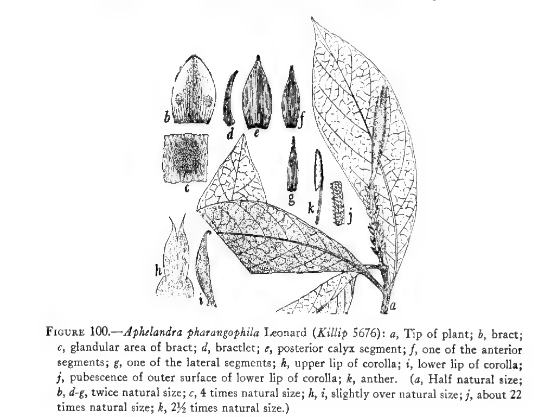
Neotropical Flora
|
Family: Acanthaceae
|
Herbs, about 1.5 meters high; stems subquadrangular, strigose, the hairs upwardly appressed, brownish, 0.5 mm. long; leaf blades ob- lanceolate to broadly oblanceolate or obovate, up to 23 cm. long and 10 cm. wide, acute to acuminate at apex (the tip itself blunt), narrowed at base and decurrent on the petiole, drying olive brown, the margins entire or undulate, the upper surface glabrous or nearly so, the costa sometimes bearing a few small appressed hairs, the lower surface rather densely pilose, the hairs brownish, appressed to ascending, about 0.5 mm. long; petioles about 1 cm. long, rather densely strigose, the hairs resembling those of the stem; spikes solitary, terminal, 3.5 to 10 cm. long, the peduncle 4 mm. long, densely strigose, the rachis glabrous or densely brownish pilose at and near insertion of the bracts, these ovate, 7 to 9 mm. long, 5 to 6 mm. wide, rounded at tip, glabrous within, densely brownish strigose without, the hairs borne medially for the most part (except the lowermost, these evenly disposed on the outer surface), the margins ciliate, the hairs 0.25 mm. long, spreading, the ocelli replaced by elliptic, dark brown, alveolate areas up to 1.25 mm. long and 0.75 mm. wide; bractlets narrowly and obliquely lanceolate, 7 mm. long, 1 mm. wide at base, gradually narrowed to a slender tip, carinate, the tip of keel densely hirsute, the hairs brownish, as- cending, 0.5 mm. long, the margins thin, glabrous and delicately striate; posterior segment of the calyx ovate, 7 mm. long, 4 mm. wide, acute, the anterior lobes lanceolate, 7 mm. long, 2 mm. wide, acute, the lateral lobes narrowly lanceolate, 6.5 mm. long, 1 mm. wide at base, slenderly acute, all of the segments finely striate, glabrous except at tips, here sparingly pilose, the hairs 0.5 mm. long; corolla 5.5 cm. long, bright red, minutely papillose, 3 mm. broad at base, narrowed at 4 mm. above base to 2 mm., thence enlarged to about 8 mm. at throat, the upper lip erect, ovate, about 2 cm. long and 1 cm. wide, bilobate at tip, the lobes triangular and slenderly acuminate, about 3 mm. long, the middle lobe of the lower lip narrowly ovate, about 2 cm. long, 5 mm. wide near middle, slenderly acuminate at tip, the lateral lobes adhering to the lower part of the upper lip, their free portions triangular, 1.5 mm. long, 1 mm. wide at base, rounded at tip; stamens about 5 cm. long, the filaments glabrous toward tip, retrorsely pilose toward base, the hairs about 0.25 mm. long, the anthers 4 mm. long, 0.75 mm. wide, rounded and minutely apiculate at base; ovary glabrous; style about as long as the stamens (?); capsule not seen. Type in the Gray Herbarium, collected in wooded ravine at La Cumbre, Department of El Valle, Colombia, 1,600 to 1,800 meters altitude, May 14-19, 1922, by E. P. Killip (No. 5676). CAUCA: Aganche, Lehmann B. T. 1165 (K, NY). TOLIMA: La Trinidad, Líbano, Pennell 3320 (NY). Quindío, Triana s. n. (Col). WITHOUT DEFINITE LOCALITY: Triana s. n. (NY). Aphelandra pharangophila is probably related to A. taborensis Leonard, agreeing rather closely in general appearance, in the size, shape, and pubescence of the leaf blades and in the color, texture and size of the corollas. The spikes of A. taborensis are, however, much more robust, the bracts being fully 10 mm. long and 7.5 mm. wide and their entire outer surface is densely and softly pubescent. The specific name is from the Greek papayέ, ravine, and pλ éw, to love. |
Powered by Symbiota.


